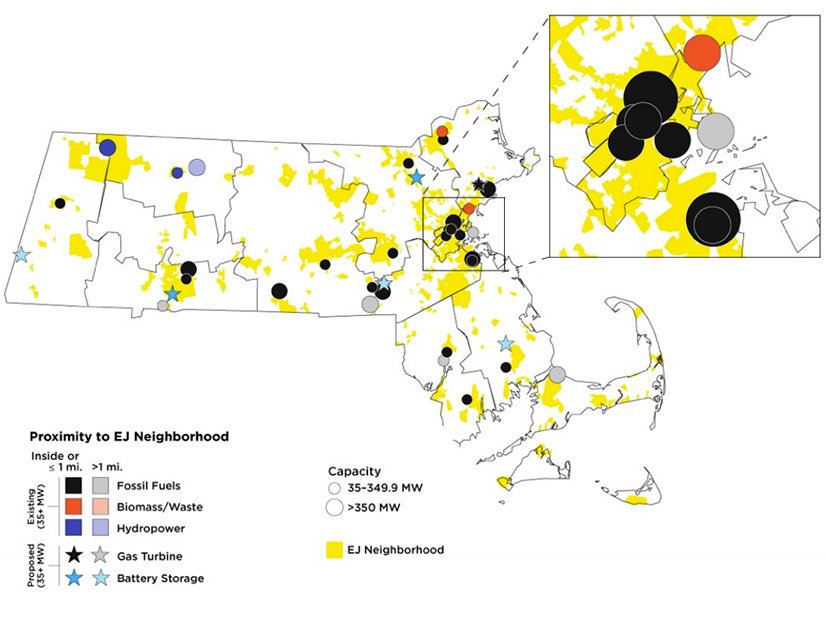
As the Massachusetts legislature gears up to address permitting and siting challenges for clean energy infrastructure, a new report shows how the state has disproportionately sited electricity infrastructure in environmental justice communities.
Authored by a coalition of climate and EJ organizations, the analysis found that more than 80% of polluting generation facilities and nearly 70% of substations are located within 1 mile of a state-designated EJ community.
Massachusetts defines EJ populations based on income, race and language barriers. The state has classified about 50% of its neighborhoods as EJ communities.
“This analysis shows yet again that environmental justice communities in Massachusetts have suffered for decades from inequitably sited energy infrastructure, bringing unhealthy and unsafe conditions like air pollution to their neighborhoods,” said lead author Paula García, senior energy analyst at the Union of Concerned Scientists.
As the state prepares for significant electricity demand growth, Massachusetts’ electric distribution companies have proposed major investments in new substations, while the state is also planning for a massive increase in solar, wind and utility-scale battery resources. (See Mass. Utilities Submit Grid Modernization Drafts.)
The state’s investor-owned utilities have proposed installing 50 new substations by 2034. Based on the available data about the location of the utilities’ new substation investments, the analysis indicated that “new substations will likely aggravate this historic trend, with seven of the 11 mapped projects proposed for siting within EJ neighborhoods.”
“The little information that is available suggests that proposed electric infrastructure will yet again disproportionately burden environmental justice communities,” said co-author John Walkey, director of climate justice and waterfront initiatives at GreenRoots. “Decision-makers must recognize this harmful pattern and establish a formal avenue for community needs to be centered in decisions happening in their own backyard.”
The authors wrote that the clean energy transition will bring climate and public health benefits to the region but stressed that clean energy projects can still have detrimental local effects. They noted that substations can impact local communities through noise pollution and risks of fires and explosions, while poorly sited renewables can impact public spaces and wildlands.
Future siting processes must do a better job incorporating the perspectives and concerns of host communities into project planning and consider the cumulative impacts of existing energy infrastructure, the authors wrote.
The analysis also called on the state to add two public members to its Energy Facilities Siting Board to represent EJ and Indigenous communities and to add climate, EJ and public health to the board’s statutory priorities.
These recommendations mirror those included in a bill in the state legislature that is supported by the organizations behind the analysis. (See Mass. EJ Groups Rally Behind Permitting, Siting Reforms.)
Co-author Sofia Owen, senior attorney at Alternatives for Community and Environment, said some lawmakers have expressed concern that adding these EJ protections to the state’s siting processes could slow the deployment of infrastructure necessary for decarbonization.
“It actually will speed things up if you have buy-in from the community,” Owen said. “I am hopeful that the administration will take to heart the things that EJ and climate justice advocates have been saying for a long time.”
Aspects of the bill supported by the organizations, H.3187, were included in a combined bill passed out of the House side of the legislature’s Joint Telecommunications, Utilities and Energy Committee.
Rep. Jeff Roy (D), co-chair of the committee, has highlighted permitting and siting reform as one of his top priorities for this legislative session. (See Mass. Lawmakers Aiming for an Omnibus Climate Bill in 2024.) Roy has introduced his own bill, which was also included in the package that was reported out of the committee.
Along with bills from the House, the state’s Commission on Energy Infrastructure Siting and Permitting is due to make recommendations to Gov. Maura Healey by the end of March, which could lead to an additional permitting and siting proposal from the administration, while the Senate could also produce its own bill.
Amid all the moving parts, top legislators are targeting the passage of an omnibus climate bill by the end of the session in July. If previous climate bills passed in the state are any indication, the negotiations could come down to the wire.

